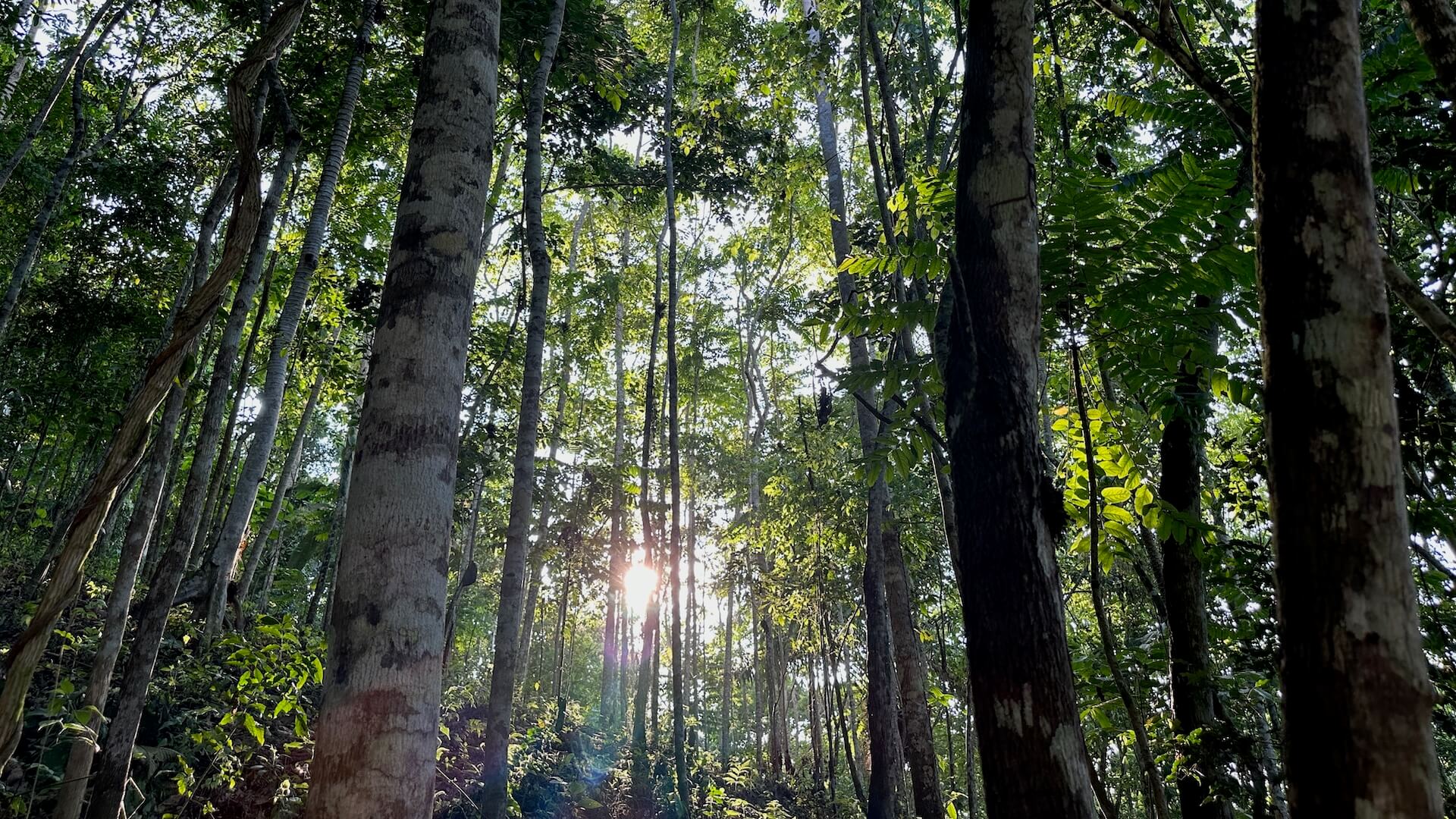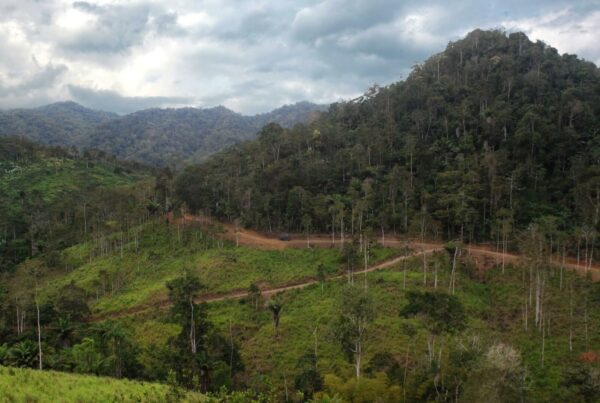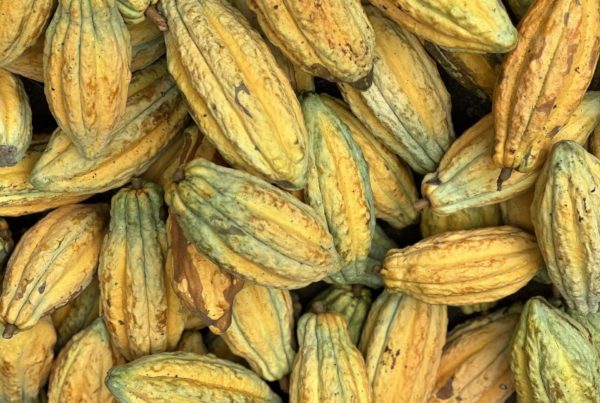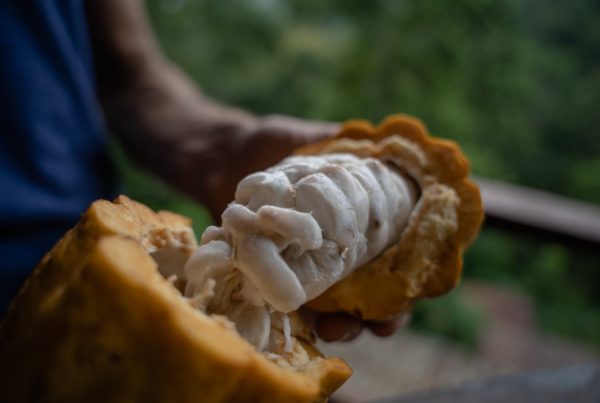Headline photo: Converting a cattle pasture to a native forest; photo taken 12 years after initial planting.
TMA has restored 427 acres of forest in coastal Ecuador since 2008. We did not do it alone. Our greatest ally in the process was Mother Nature. Along the way, we’ve had the opportunity to implement and experiment with a full quiver of different reforestation methodologies, each of which we summarize below.
We also go into detail about the art and science of these methodologies in Judo Principles of Tropical Reforestation: 9 lessons learned from reforesting 427 acres in Ecuador.
The list of methodologies covered in this article includes:
- natural regeneration (NR)
- assisted natural regeneration (ANR)
- enrichment planting (ER)
- plantation-style reforestation (PS)
- delayed planting (DP)
- nurse cropping (NC)
- applied nucleation (AN)
- farmer managed natural restoration (FMNR)
- permaculture
- regenerative agroforestry (RA)
- syntropic agroforestry
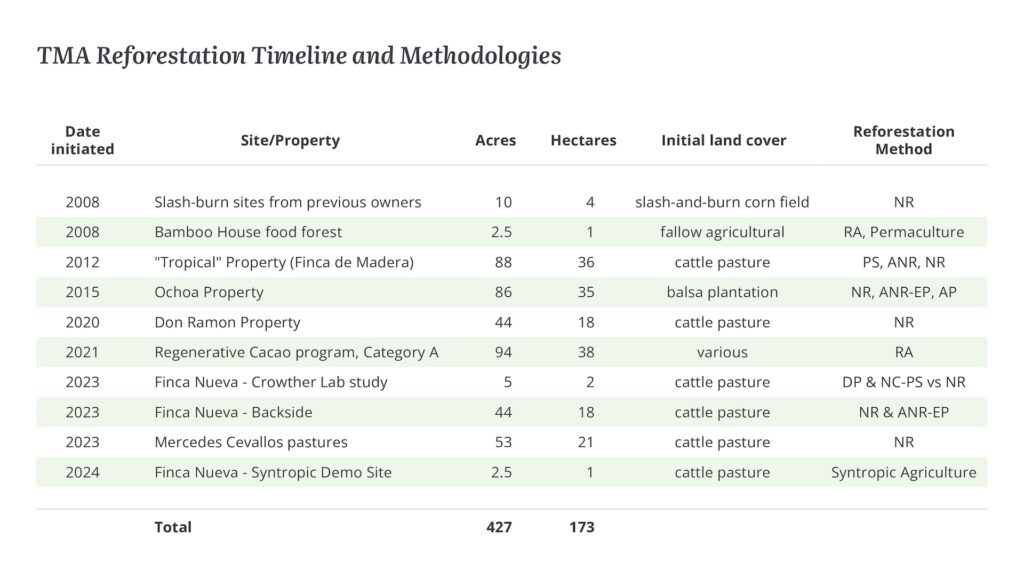
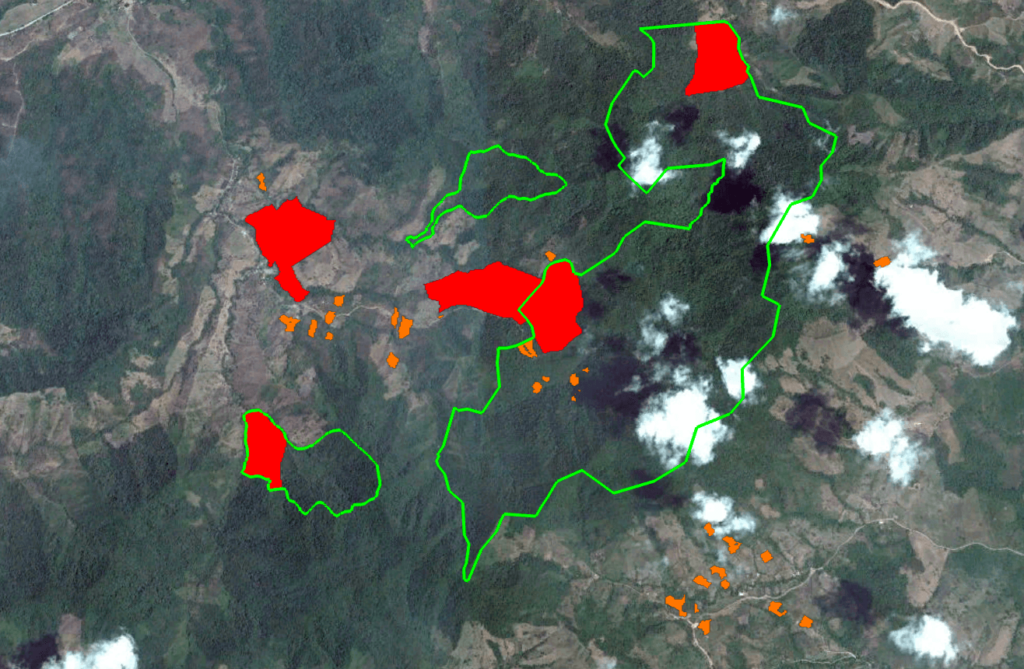
Map of TMA reforestation projects. The Jama-Coaque Reserve is outlined in green; native forest restoration projects are in red; regenerative agroforestry parcels are in orange.
Summary of Methodologies
The following is a brief summary of each reforestation method, along with an explanation of the difference between rewilding and reforestation.
Natural Regeneration (NR)
Natural Regeneration is a forest recovery process where trees and plants regrow naturally without human intervention, using existing seeds and sprouts in the area. It is the most cost-effective method for forest restoration because it relies on the innate ability of ecosystems to heal themselves through the process known as natural forest succession.
Sites most suitable for natural regeneration are those where the ecological conditions remain relatively intact, with minimal presence of invasive species that could compete with native growth. It is greatly facilitated by the presence of a nearby forest, which serves as a seed bank. Animals such as a birds, bats, and other mammals play a critical role in dispersing seeds from nearby forest into the natural restoration area.
We’ve used NR to restore slash-and-burn sites, cattle pasture, and part of the ex-balsa plantation.
Assisted Natural Regeneration (ANR)
Assisted Natural Regeneration is a forest restoration method in which humans merely give Mother Nature a helping hand, Humans accelerate the process of natural forest succession by actively removing obstacles to forest recovery.
One way to do this is by strategically chopping-and-dropping any vegetation that threatens to stifle the growth of desirable tree seedlings and saplings that have naturally sprouted. It also may be necessary to shield the young seedlings from damage caused by herbivores or trampling.
Whereas NR basically requires no human effort, ANR usually only requires minimal human effort. For this reason, it is much more cost-effective than conventional tree-planting methods of reforestation.
ANR is best suited to areas where the natural seed bank is still viable but hampered by overgrowth, disturbances, or other stressors that prevent successful seedling establishment and growth. It may not be effective in heavily degraded areas that are far from existing tracts of mature forest.
ANR is partially responsible for the success of our finest section of the Finca de Madera reforestation project.
Enrichment Planting (EP)
Enrichment Planting is an optional add-on component of ANR. In cases where the quantity or diversity of volunteer trees is insufficient to restore the forest on its own, you can also plant additional trees from targeted species. This helps enhance biodiversity, fill in spatial gaps, and restore key ecological functions.
In this case, planting densities still tend to be quite low. Whereas some conventional plantation-style reforestation projects plant trees with spacing of 2×2 meters or 3×3 meters, the spacing for enrichment planting may be 10×10 meters or even as wide as 25×25 meters. Although EP trees usually aren’t planted according to a grid. Rather, they are planted wherever there happens to be gap without promising volunteer seedlings or saplings.
In a few of our ANR-EP sites in and around the Jama-Coaque Reserve, we generally plant native timber species that have suffered significant population loss due to logging.
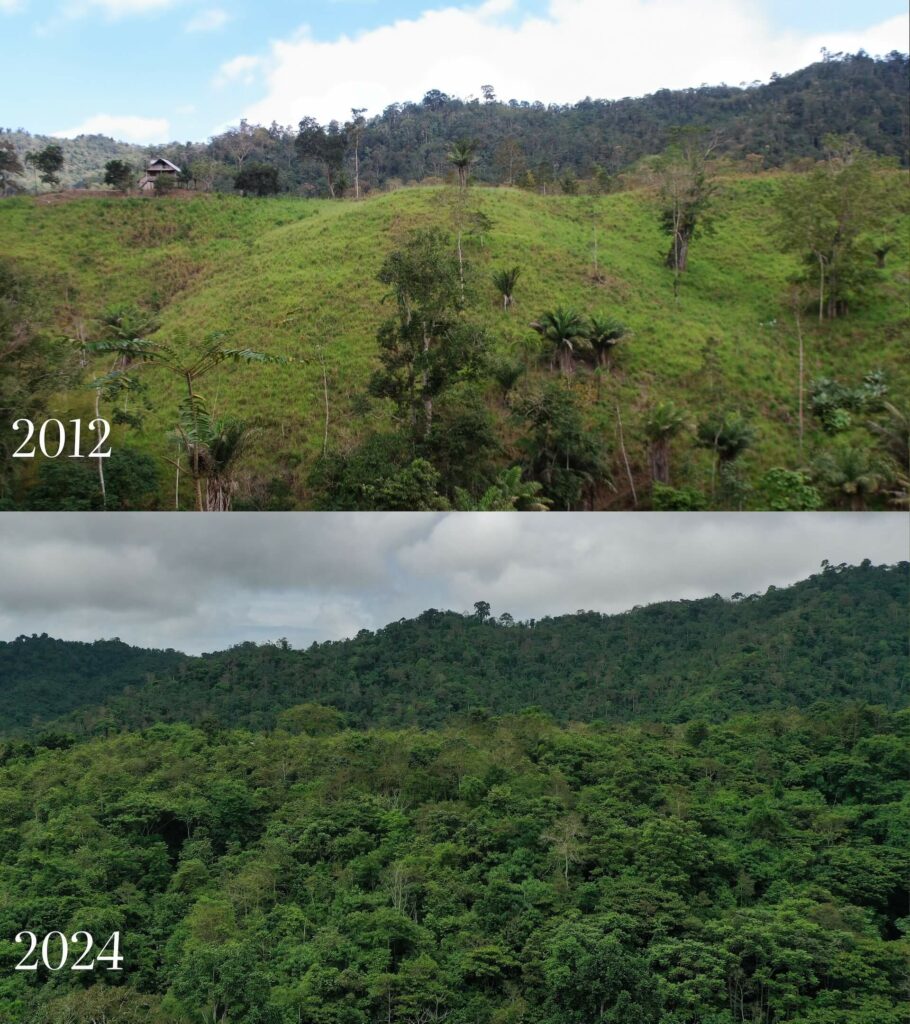
The “Finca de Madera” reforestation project, before and after.
Plantation-Style Reforestation (PS)
Plantation-style reforestation is what most people think of when they think of reforestation. You plant rows and rows of trees, usually with standardized spacing, into deforested land. This is by far the most time-consuming and expensive form of reforestation. For this reason, it should only be used at sites where less labor-intensive methods like NR, ANR-EP, or AN would not be effective. In other words, in severely degraded sites where the process of natural forest succession is greatly hindered.
We made the mistake of attempting PS in year 1 of our first cattle pasture reforestation project. The survival rate was about 50%. In our study with the Crowther Lab, which also called for active tree planting into a cattle pasture, we paired PS with Nurse Cropping (NC), and this time the initial survival rates were well over 80%.
Delayed Planting (DP)
Delayed Planting is a strategy where the planting of trees is postponed for a few years to allow the first wave of natural forest succession to establish an initial layer of native vegetation. This helps create more favorable soil and microclimate conditions for tree seedlings that are eventually planted into the site.
This method is particularly advantageous when attempting to reforest a cattle pasture—as we have learned through many tough years of trial and error. Plant inherently vulnerable tree seedlings directly into the dry and sun-scorched conditions of a cattle pasture is akin to asking soldiers to walk into a line of enemy fire. Even if some of the seedlings don’t die, they will require labor-intensive support (primarily in the form of manual weeding) every three months for the first few years.
In the delayed planting approach, you wait two or three years so that pioneer species begins to shade out the pasture grass and create a more suitable growing environment for the seedlings. This greatly reduces labor costs and increases seedling survival rates. In effect, you outsource the crucial first few years of work to Mother Nature herself. She handles that part of the job much more efficiently than humans.
We’re using the delayed planting method in three out of the 13 experimental plots in the Crowther Lab study. We discuss this method in greater detail in The Judo Approach to Reforestation: 9 lessons learned from reforesting 427 acres in Ecuador.
Nurse Cropping (NC)
Nurse Cropping is a reforestation method that plants fast-growing pioneer species alongside slower-growing target species. This is yet another way of hacking the natural process of forest succession. The fast-growing pioneer trees pave the way for slower-growing, longer-lived species that will eventually become the backbone of the forest.
Nurse cropping is similar to delayed planting, in the sense that fast-growing (early successional) species are used to create more favorable growing conditions for slower-growing (later-successional) species. In delayed planting, you wait for nature to generate her own crop of pioneer trees, in the form of volunteer trees that naturally seed and/or sprout on the site. With nurse cropping, you go ahead and actually plant the pioneer trees yourself.
It is possible to use nurse cropping in the context of delayed planting. With that approach, you would allow native vegetation to regrow on its own for a few years. And then you can plant additional pioneer trees as well as slower-growing target species at the same time. Or you could plant pioneer trees and wait a few years before planting slower-growing target species. Or you can simply plant everything together right at the outset.
In all cases, the concept is the same. Slower-growing and longer-lived tree species are generally accustomed to spending the first few years of their lives in the dappled shade of a forest. In this relatively stable and comfortable environment, the young seedlings and sapling patiently bide their time until a nearby tree falls and creates a gap in the canopy. At this point, they have deep enough roots to tap into subsurface waterflow. They are also usually tall and strong enough to outcompete so-called weeds and grasses that would have otherwise stunted their growth as baby seedlings. Thus, they are now capable of taking advantage of the sunlight and can quickly grow skyward.
By this point, the nurse trees have fulfilled their function. In accordance with natural forest succession, the nurse trees would inevitably die on their own, to make way for the next wave of succession. Humans can accelerate this process by cutting them back or thinning them. This provides a fresh supply of decomposing organic material on the forest floor, which helps cycle nutrients, protect the soil, and improve soil fertility—further enhancing the growth prospects of the target trees.
Our preferred nurse tree is balsa (Ochroma pyramidale), a pioneer species native to this region. It’s a short-lived tree that can outcompete pasture grass and grow more than 15 feet per year. We used balsa trees as nurse crops in six out of the 13 experimental plots in the Crowther Lab study. We’re now using balsa as nurse crops in some of our regenerative agroforestry sites with local farmers.
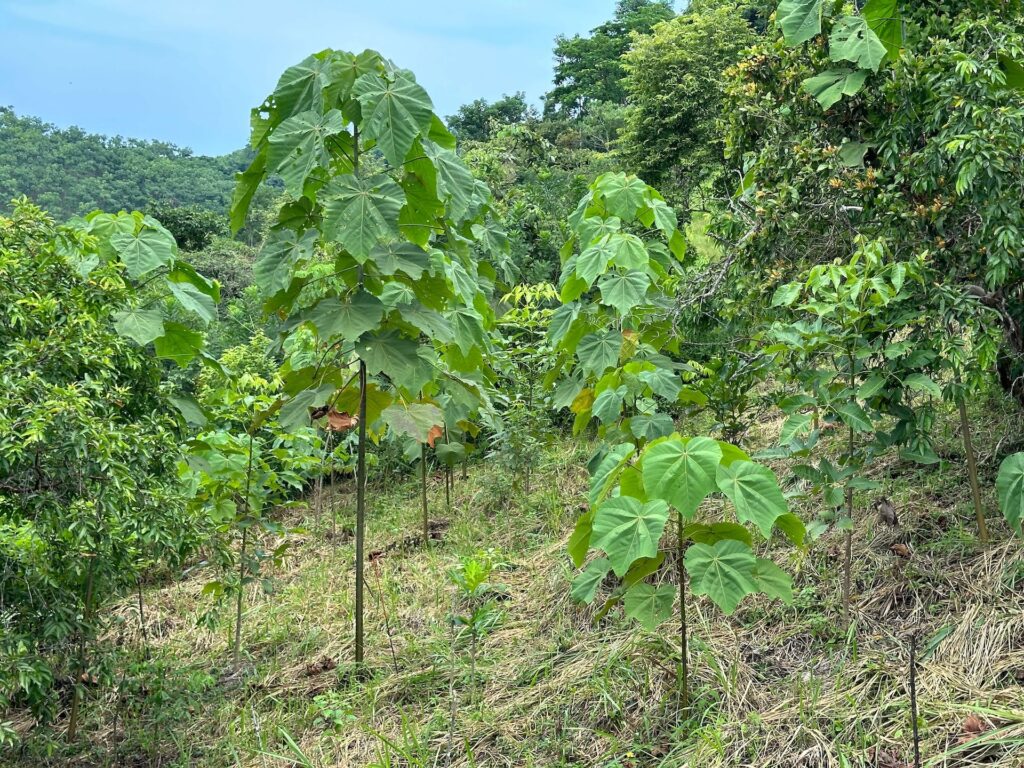
Balsa trees (native to this region) employed as nurse crops to longer-successional species. (Finca Nueva – Crowther Study Plot)
Applied nucleation (AN)
Applied nucleation (AN) is a reforestation technique that involves planting small clusters of trees to serve as focal points for natural forest succession. These clusters (or “nuclei”) attract birds and insects and other animals that act as seed dispersers and pollinators, which accelerates forest recovery. Over time, these nuclei grow and merge, gradually restoring the forest ecosystem across a broader area. Applied nucleation can be preferable to plantation-style tree planting because it uses a lot less labor and inputs to achieve comparable results.
This method was an important feature in the large-scale reforestation efforts in Auroville, India in the 1970s and 1980s. Applied Nucleation has been extensively studied by Doctors Karen Holl, Rakan Zahawi, and their colleagues in Costa Rica. We’re applying AN in the ex-balsa plantation.
Farmer Managed Natural Regeneration (FMNR)
Farmer Managed Natural Regeneration is a low-cost, sustainable land restoration technique that encourages the natural regrowth of trees and bushes from existing roots and stumps, which farmers manage by pruning and protecting new shoots. This approach enhances agricultural productivity, improves soil health, and increases biodiversity. It was specifically developed for the cultural and climate conditions of the arid tropics of sub-Saharan Africa as a tool to combat desertification.
We’ve experimented with FMNR in a few of the regenerative agroforestry parcels with local farmers—particularly on properties with large populations of existing Guazuma ulmifolia trees.
Permaculture
Permaculture is a holistic agricultural system that integrates land, resources, people, and native ecology in a synergistic way. It imitates the no-waste, closed-loop systems observed in diverse natural environments, but reoriented in pursuit of sustainable production of food, shelter, and other needs. It places a premium on conscious design and seeks to achieve human prosperity and well-being in a way that is aligned with nature. It also emphasizes social aspects like community building and fair resource distribution. Permaculture is guided by three core ethics: care for the earth, care for people, and fair share.
Permaculture, as a system, was first coined in Tasmania in the 1970s by Bill Mollison and David Holmgren. They were inspired by a combination of Tasmanian Aboriginal practices, the “natural farming” method of Japanese farmer and philosopher Masanobu Fukuoka, the “mulch gardening” methods of American gardener and writer Ruth Stout, and the writings of Stuart Brand, and other influences.
The philosophy of permaculture was an important contributor to the creation of TMA and the founding of the Jama-Coaque Reserve. It was also the framework we used to design the food forest and production zone surrounding the Bamboo House.
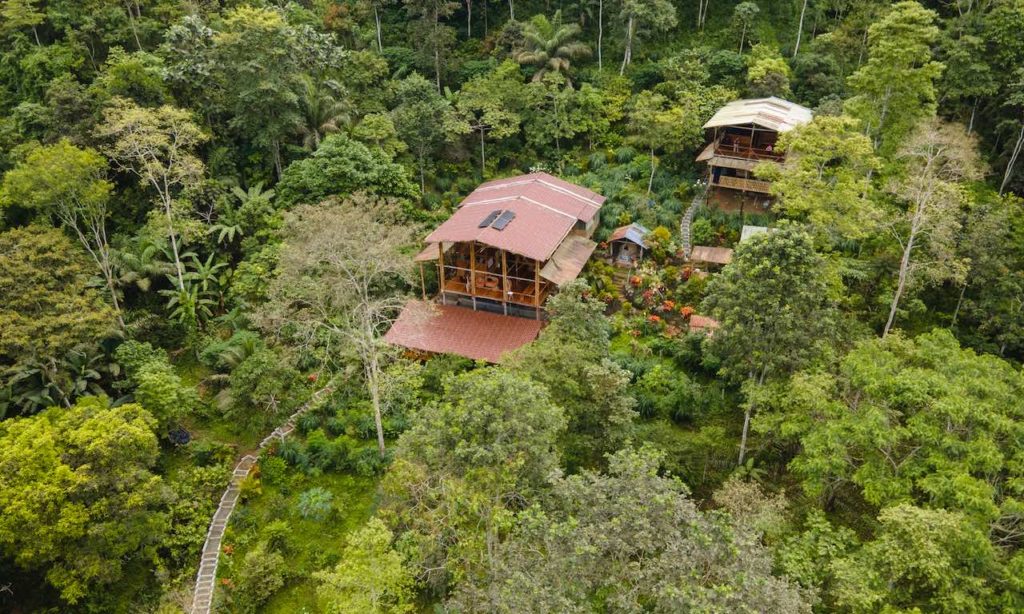
Permaculture/regenerative agroforestry surrounding the Bamboo House.
Regenerative Agroforestry (RA)
Regenerative agroforestry combines tree crops alongside other agricultural practices to simultaneously restore ecosystem health, increase biodiversity, and achieve sustainable food production.
A key feature of agroforestry, in general, is diversity in the elements that are cultivated. Whereas conventional agriculture and conventional plantations tend to be monocultures of one species, agroforestry includes a mix of different species, ranging from fruit trees and timber trees to perennial or annual crops, and may also include nitrogen-fixing species and even livestock.
Another key feature is a multi-strata system, in which trees and plants of different heights are cultivated together—somewhat mimicking the structure of a forest.
Agroforestry is considered “regenerative” if it is used as a tool to restore tree cover and improve the biodiversity and/or soil fertility of land that was formerly used in an unsustainable fashion—for example, a cattle pasture or monoculture crop plantation.
Regenerative agroforestry prioritizes soil management through practices like mulching, no-till farming, and the use of organic fertilizers to promote a healthy soil ecosystem. Water conservation techniques such as contour planting, swales, and other water-harvesting methods can also be used. This helps manage water efficiently, reduce irrigation needs, and increase resilience in times of drought.
In some cases, livestock is also incorporated in the system. In addition to producing food, livestock can be used for “weed” management, pest control, and manure production. The latter supports crop health and growth by cycling nitrogen and other nutrients back into the soil.
If implemented well, regenerative agroforestry has the capacity to enhance biodiversity, rejuvenate soils, combat climate change, and sustainably produce food, timber, and other human needs.
Our Regenerative Cacao program, which has now extended to 80 different farms across the region, is built on these principles. The photo below illustrates the results after just three and a half years.
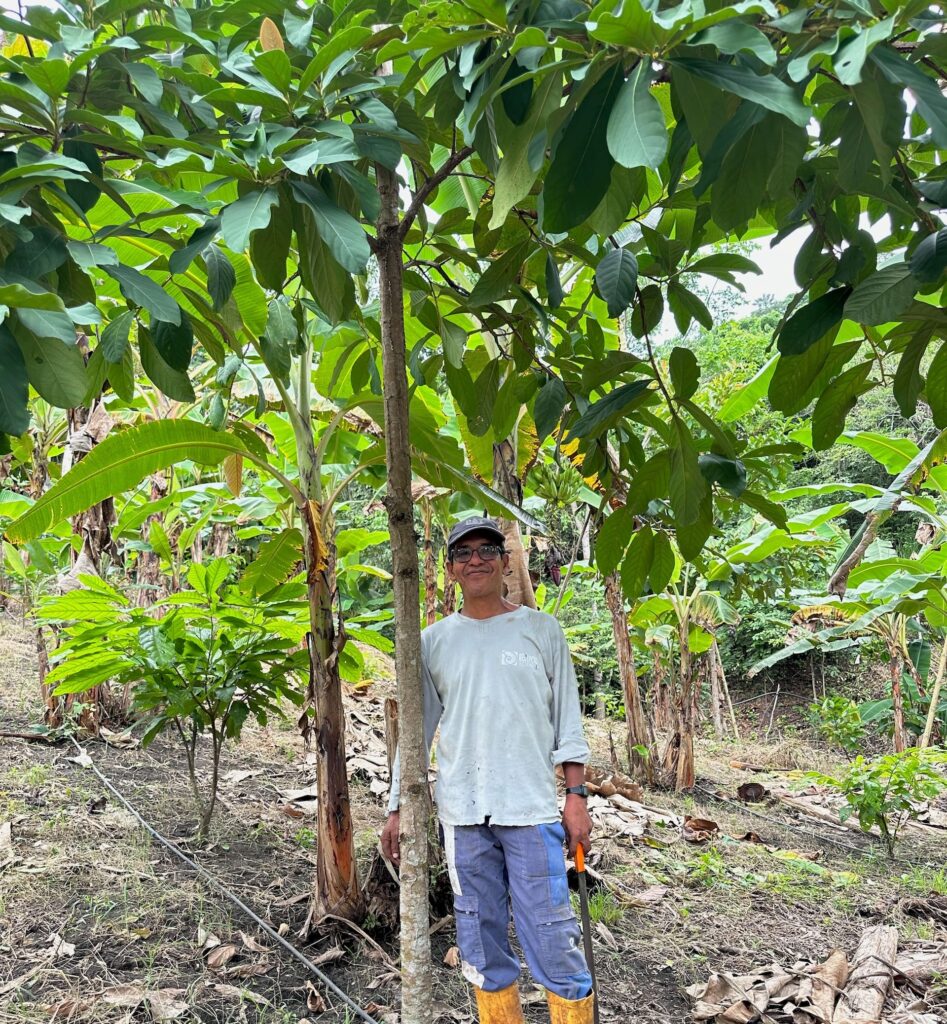
One of the inaugural members of Regenerative Cacao program standing in his farm three and a half years after initial planting. Native hardwood in the foreground, followed by banana and cacao.
Syntropic Agroforestry
Syntropic agriculture is a distinct form of regenerative agroforestry that is built upon a specific theory with a specific methodology. It is predicated on leveraging ecological succession for the sake of building soil and producing food. Different trees and plants are grown together in planned stages that mimic the natural progression of an ecosystem. However, syntropic agriculture is most often planted in straight lines on flat land.
Pruning and biomass recycling are key drivers of the process, in a way that goes beyond conventional notions. In syntropic agriculture, pruning is meant to mimic the natural disturbances that drive ecological succession in native forests, in this case augmented by conscious human intention.
Pruning is strategically used to manage plant growth, redirect energy to targeted areas of the system, and stimulate the development of other plants by enhancing light penetration, reducing competition, and other mechanisms. Biomass generated from pruning is cycled back into the system as mulch, which decomposes to enrich the soil with nutrients, improve soil structure, and support microbial activity. This stimulates growth and production throughout the system, and generally promotes a healthy, self-sustaining agricultural ecosystem.
Ernst Götsch, a Swiss farmer and researcher, developed the concept of syntropic agriculture after moving to Brazil in the 1980s. The method has been widely replicated in other parts of the world. Our friend Lucas Oshun is its leading practitioner in coastal Ecuador.
We’re managing a 1-hectare syntropic agriculture demonstration site right next to our cacao processing facility in Camarones.
Rewilding vs Reforestation
What’s the difference between these two terms? It’s a fair question. Rewilding and reforestation are both environmental restoration strategies, but they have distinct goals and methods. Rewilding focuses on restoring natural ecosystems and processes—in some cases including the reintroduction of native wildlife—to create self-sustaining environments with minimal human intervention. Reforestation, on the other hand, specifically involves planting trees to restore deforested or degraded forest lands. While rewilding aims to restore an entire ecosystem, reforestation primarily targets increasing tree cover and forest health.
Permaculture, regenerative agroforestry, syntropic agriculture, and FMNR can all be considered reforestation tools, but not rewilding. Although they contribute to restoring nature and biodiversity, they’re also designed to produce food and other products for human consumption.
Natural Regeneration, Assisted Natural Regeneration, Enrichment Planting, Applied Nucleation, Nurse Cropping, Delayed Planting, and even plantation-style reforestation can all be considered tools for rewilding if their goal is simply to restore natural ecosystems to a native state. In other words, if the forested land that results from these methods are not used to produce material goods for human consumption, like food or timber.
